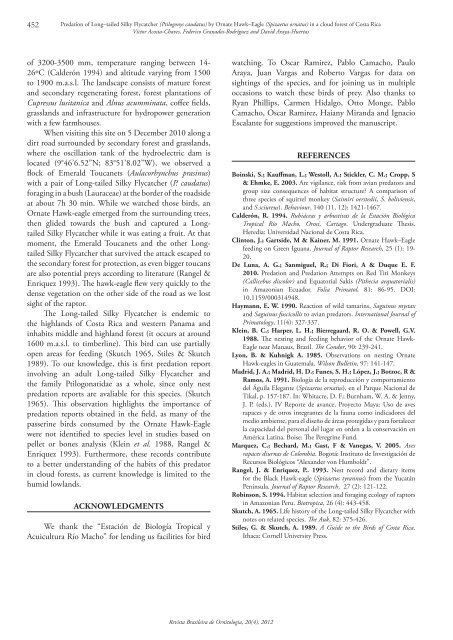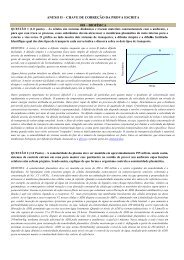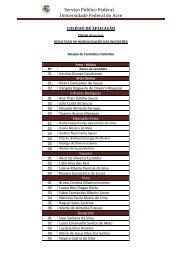Revista Brasileira de Ornitologia - Universidade Federal do Acre
Revista Brasileira de Ornitologia - Universidade Federal do Acre
Revista Brasileira de Ornitologia - Universidade Federal do Acre
You also want an ePaper? Increase the reach of your titles
YUMPU automatically turns print PDFs into web optimized ePapers that Google loves.
452Predation of Long–tailed Silky Flycatcher (Ptilogonys caudatus) by Ornate Hawk–Eagle (Spizaetus ornatus) in a cloud forest of Costa RicaVíctor Acosta-Chaves, Fe<strong>de</strong>rico Grana<strong>do</strong>s-Rodríguez and David Araya-Huertasof 3200-3500 mm, temperature ranging between 14-26ºC (Cal<strong>de</strong>rón 1994) and altitu<strong>de</strong> varying from 1500to 1900 m.a.s.l. The landscape consists of mature forestand secondary regenerating forest, forest plantations ofCupressus lusitanica and Alnus acumminata, coffee fields,grasslands and infrastructure for hydropower generationwith a few farmhouses.When visiting this site on 5 December 2010 along adirt road surroun<strong>de</strong>d by secondary forest and grasslands,where the oscillation tank of the hydroelectric dam islocated (9°46’6.52”N; 83°51’8.02”W), we observed aflock of Emerald Toucanets (Aulacorhynchus prasinus)with a pair of Long-tailed Silky Flycatcher (P. caudatus)foraging in a bush (Lauraceae) at the bor<strong>de</strong>r of the roadsi<strong>de</strong>at about 7h 30 min. While we watched those birds, anOrnate Hawk-eagle emerged from the surrounding trees,then gli<strong>de</strong>d towards the bush and captured a LongtailedSilky Flycatcher while it was eating a fruit. At thatmoment, the Emerald Toucanets and the other LongtailedSilky Flycatcher that survived the attack escaped tothe secondary forest for protection, as even bigger toucansare also potential preys according to literature (Rangel &Enriquez 1993). The hawk-eagle flew very quickly to the<strong>de</strong>nse vegetation on the other si<strong>de</strong> of the road as we lostsight of the raptor.The Long-tailed Silky Flycatcher is en<strong>de</strong>mic tothe highlands of Costa Rica and western Panama andinhabits middle and highland forest (it occurs at around1600 m.a.s.l. to timberline). This bird can use partiallyopen areas for feeding (Skutch 1965, Stiles & Skutch1989). To our knowledge, this is first predation reportinvolving an adult Long-tailed Silky Flycatcher andthe family Ptilogonatidae as a whole, since only nestpredation reports are avaliable for this species. (Skutch1965). This observation highlights the importance ofpredation reports obtained in the field, as many of thepasserine birds consumed by the Ornate Hawk-Eaglewere not i<strong>de</strong>ntified to species level in studies based onpellet or bones analysis (Klein et al. 1988, Rangel &Enriquez 1993). Furthermore, these records contributeto a better un<strong>de</strong>rstanding of the habits of this predatorin cloud forests, as current knowledge is limited to thehumid lowlands.ACKNOWLEDGMENTSWe thank the “Estación <strong>de</strong> Biología Tropical yAcuicultura Río Macho” for lending us facilities for birdwatching. To Oscar Ramirez, Pablo Camacho, PauloAraya, Juan Vargas and Roberto Vargas for data onsightings of the species, and for joining us in multipleoccasions to watch these birds of prey. Also thanks toRyan Phillips, Carmen Hidalgo, Otto Monge, PabloCamacho, Oscar Ramirez, Haiany Miranda and IgnacioEscalante for suggestions improved the manuscript.REFERENCESBoinski, S.; Kauffman, L.; Westoll, A.; Stickler, C. M.; Cropp, S& Ehmke, E. 2003. Are vigilance, risk from avian predators andgroup size consequences of habitat structure? A comparison ofthree species of squirrel monkey (Saimiri oerstedii, S. boliviensis,and S.sciureus). Behaviour, 140 (11, 12): 1421-1467.Cal<strong>de</strong>rón, R. 1994. Rubiáceas y arbustivas <strong>de</strong> la Estación BiológicaTropical Río Macho, Orosi, Cartago. Un<strong>de</strong>rgraduate Thesis.Heredia: Universidad Nacional <strong>de</strong> Costa Rica.Clinton, J.; Gartsi<strong>de</strong>, M & Kainer, M. 1991. Ornate Hawk–Eaglefeeding on Green Iguana. Journal of Raptor Research, 25 (1): 19-20.De Luna, A. G.; Sanmiguel, R.; Di Fiori, A & Duque E. F.2010. Predation and Predation Attempts on Red Titi Monkeys(Callicebus discolor) and Equatorial Sakis (Pithecia aequatorialis)in Amazonian Ecua<strong>do</strong>r. Folia Primatol, 81: 86-95. DOI:10.1159/000314948.Haymann, E. W. 1990. Reaction of wild tamarins, Saguinus mystaxand Saguinus fuscicollis to avian predators. International Journal ofPrimatology, 11(4): 327-337.Klein, B. C.; Harper, L. H.; Bierregaard, R. O. & Powell, G.V.1988. The nesting and feeding behavior of the Ornate Hawk-Eagle near Manaus, Brazil. The Con<strong>do</strong>r, 90: 239-241.Lyon, B. & Kuhnigk A. 1985. Observations on nesting OrnateHawk-eagles in Guatemala. Wilson Bulletin, 97: 141-147.Madrid, J. A.; Madrid, H. D.; Funes, S. H.; López, J.; Botzoc, R &Ramos, A. 1991. Biología <strong>de</strong> la reproducción y comportamiento<strong>de</strong>l Águila Elegante (Spizaetus ornatus), en el Parque Nacional <strong>de</strong>Tikal, p. 157-187. In: Whitacre, D. F.; Burnham, W. A. & Jenny,J. P. (eds.). IV Reporte <strong>de</strong> avance, Proyecto Maya: Uso <strong>de</strong> avesrapaces y <strong>de</strong> otros integrantes <strong>de</strong> la fauna como indica<strong>do</strong>res <strong>de</strong>lmedio ambiente, para el diseño <strong>de</strong> áreas protegidas y para fortalecerla capacidad <strong>de</strong>l personal <strong>de</strong>l lugar en or<strong>de</strong>n a la conservación enAmérica Latina. Boise: The Peregrine Fund.Marquez, C.; Bechard, M.; Gast, F & Vanegas, V. 2005. Avesrapaces diurnas <strong>de</strong> Colombia. Bogotá: Instituto <strong>de</strong> Investigación <strong>de</strong>Recursos Biológicos “Alexan<strong>de</strong>r von Humboldt”.Rangel, J. & Enriquez, P.. 1993. Nest record and dietary itemsfor the Black Hawk-eagle (Spizaetus tyrannus) from the YucatánPeninsula. Journal of Raptor Research, 27 (2): 121-122.Robinson, S. 1994. Habitat selection and foraging ecology of raptorsin Amazonian Peru. Biotropica, 26 (4): 443-458.Skutch, A. 1965. Life history of the Long-tailed Silky Flycatcher withnotes on related species. The Auk, 82: 375-426.Stiles, G. & Skutch, A. 1989. A Gui<strong>de</strong> to the Birds of Costa Rica.Ithaca: Cornell University Press.<strong>Revista</strong> <strong>Brasileira</strong> <strong>de</strong> <strong>Ornitologia</strong>, 20(4), 2012










